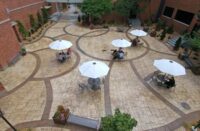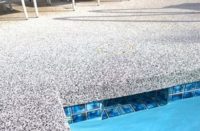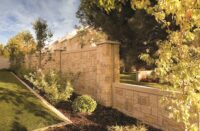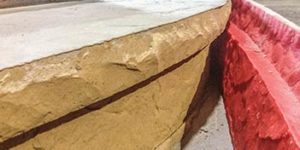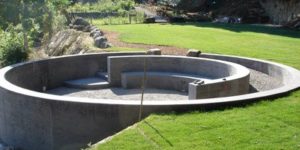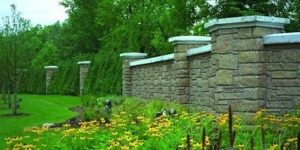
One of the greatest advantages of working in concrete is its versatility. When viewed as an artistic medium rather than simply a construction component, the material offers infinite possibilities for creativity. Many tools for expressing this creativity have been around for a long time, but they are finding new uses. One proven system receiving renewed attention is form liners.

Form liners are essentially molds for giving texture and design to vertical concrete surfaces. Dana Scott, marketing director of Scott System, Denver, Colo., describes form liners as “a reverse stamp.” Instead of pouring the concrete and applying a texturing tool, the tool (the form liner) is attached to the form and concrete poured onto it.
Form liners have been widely used for years to beautify otherwise ordinary structures such as highway walls, sound barriers, bridge supports and retaining walls. This market continues to grow as more and more communities demand beauty as well as functionality from their highway systems. In many cases, budgets for these projects include a required amount for art, a requirement that can be met with form liners.

Municipal structures like picnic pavilions, pumping stations and restrooms are often constructed with concrete because of its longevity and ease of maintenance. However, more communities are now demanding that these structures be aesthetically pleasing as well as functional. As Isaac Sparks of Hunt Valley Contractors Inc., in Owings Mills, Md., explains, “Nobody wants an eyesore in their backyard.” Form liners offer a practical technique for beautifying even these mundane structures. Sparks estimates using architectural concrete adds just 2 percent to 5 percent to the cost of the finished project.
In addition to traditional uses in roadways and public buildings, contractors and designers are starting to see new opportunities for using form liners in commercial projects, residential construction and landscaping.
Form lining systems
There are various materials and technologies for manufacturing form liners and each type has different uses and advantages. Plastic liners have the lowest initial cost, but typically can be reused only a few times, if at all. They come in standard sizes and textures and so are not suitable for large or custom projects. Their low cost per square foot (from $2 to $8 depending on the material) makes them attractive for smaller-scale projects where there is no economy to be gained from multiple uses

Urethane form liners are probably the most familiar and widely used. Scott System is one company that has been making urethane form liners for a long time. In fact, founder Buck Scott was the first to use elastomeric urethane as a mold material in the late 1960s. (He holds 20 patents related to form liners and brick embedded concrete systems.) Because urethane imparts clear detail to concrete, early form liners were used to beautify walls along highways, an application that is still a big part of Scott System’s business today.
Urethane is also durable, which makes the liner highly reusable. The more times the liner can be reused, the more economical it becomes. For example, Jim Bohrer, a director at Custom Rock Form Liner, St. Paul, Minn., says that precasters reuse Custom Rock’s Dura-Form liner between 50 and 100 times.
Large urethane form liners can be difficult to work with because they are heavy. Isaac Sparks, whose company Hunt Valley Distributors Inc. distributes Custom Rock liners, explains that patterns with a deeper reveal require thicker liners, which are made with foam-filled urethane to reduce the weight.
A brand new system for creating patterns for form liners comes from Europe and was introduced in North America at this year’s World of Concrete. The Vectogramme Form Liner from German company Reckli is a computer-based, multi-step process for transferring an image onto a urethane form liner and, from there, to concrete. According to the company’s literature, virtually any image in standard graphic format, like a logo or even a black and white photo, can be transferred. The Vectogramme system is distributed in North America by a Canadian company called Distrimat

Another new system for texturing vertical concrete is not a liner at all. In 2004, Architectural Concrete Creations, Warren, Mich., introduced its new Arch-Crete wall forming system at World of Concrete, where it was recognized as a “Most Innovative Product.” Arch-Crete is a manufactured form that combines a textured face with an integrated reinforcement matrix for support. No additional liner is needed. Company spokesman Hatem Hannawa names significant differences between the Arch-Crete system and traditional liners. First is cost. While a liner may cost $22 to $24 a square foot plus $12 a square foot for framework, this system costs about $22 a square foot total. It can also reduce labor costs by eliminating the step of fastening the liner to the form or backerboard every few inches. The system is generally lighter than standard forms and liners — about 57 pounds for a 3-by-6-foot form. Finally, the polypropylene and copolymer composition does not absorb water, so it releases from the set concrete easily and is extremely durable. Independent tests conducted by filling, vibrating, purging, rinsing and refilling the form indicated that it can be used for 1,500 pours. Besides the standard forms, Arch-Crete forms come in corners, T-walls, intersections, piers and columns.

Custom form liners can be manufactured to create almost any design desired. Leaves, fossils, mountains or local cultural icons are popular custom designs. Reusable form liners in standard designs are the most economical to use and these patterns, like many concrete imprint systems, echo natural stone — river rock, cobblestone, boulders, etc. Custom Rock actually uses real stone to mold their urethane liners. Their patented system is designed to create a nonrepeating pattern by using liners that can be rotated and “puzzled” together to avoid a straight line where one liner meets the next.
Other form liner patterns include wood, bricks or blocks, and the “fractured” ridges that are closely associated with vertical concrete. Rock shapes made of concrete are significantly less expensive than natural stone and stone veneers.
Cast-in-place, MSE and precast
Form liners can be used with just about any method of casting concrete for vertical uses. When used for cast-in-place projects, liners can be attached to both sides of the form so both sides of the concrete can be textured at the same time. Cast-in-place is used on-site for large installations and is well-suited for art installations.
 Casting on site with form liners is beginning to find its way into the residential market. Steve Chakonas, president of Complete Concrete in Sykesville, Md., first saw form liners at Hunt Valley Distributors when he was picking up supplies for imprinting flatwork. He soon realized he could use form liners and concrete instead of dry stacked stone to quickly build seating walls and garden retaining walls.
Casting on site with form liners is beginning to find its way into the residential market. Steve Chakonas, president of Complete Concrete in Sykesville, Md., first saw form liners at Hunt Valley Distributors when he was picking up supplies for imprinting flatwork. He soon realized he could use form liners and concrete instead of dry stacked stone to quickly build seating walls and garden retaining walls.
“We’re giving people a prettier look than just dry stack stones,” Chakonas says. “We’ll pour a wall in a dry stack pattern and top it with granite to make a sitting wall or property divider. It looks better because we can stain it different colors. It goes nicely with all our stamped concrete. And I can control the job. I pour the footer and wall at the same time. Later that day I strip the form and it’s done.”
Chakonas says he can do in a day what ordinarily might take three or four days. “And because it weighs 2 tons for every 10 feet, it is a true retaining wall.”
Mechanically stabilized earth (MSE) panels are used specifically for large retaining walls. Reinforced Earth panels made by The Reinforced Earth Co. are made of layers of granular backfill and reinforcing strips. They have a high load-carrying capacity and so are used for very tall or heavy-loaded retaining walls like those along highways or rail lines. They are faced with modular precast concrete with textures created using form liners.
Precasting with form liners may be the area of greatest innovation right now. Of course, precast has a set of unique advantages. Forms that are made in the shop can be made to tight specifications and reused multiple times. Concrete is poured and cured under clean, controlled conditions for consistently high quality. Timing is controllable and not dependent on other trades. All of these add up to the capability to replicate panels of the same quality to the same specifications time after time. Jim Bohrer, director of Custom Rock Form Liner, says this technique is valuable for sound walls and wing walls for precast bridge sections, among other uses

Brick patterns are popular for projects like homes, parking structures and commercial buildings. Scott System makes several products that deliver a brick look. A form liner in a brick pattern was used for housing in Denver’s Montbello neighborhood in the early 1970s. Scott System also developed a liner that allowed the contractor to insert thin bricks into gaskets and pour concrete over the back of the assembly. The concrete and bricks become an integrated structural panel. This product evolved into the Brick Snap system, where individual thin bricks supplied with plastic carriers are placed into the form, the concrete poured, the panels erected and the disposable plastic templates removed. This system is more practical for tilt-up applications where many panels are cast at once, unlike precast operations where the same form liner can be used multiple times in sequence. The Melrose Housing Project in the South Bronx was built using Scott System’s Brick Snaps for the walls and a traditional form liner for a contrasting entry. Dana Scott estimates that demand from the tilt-up market for this product has increased 40 percent nearly every year since it was introduced in 1996.
Demand for architectural concrete has grown explosively over the past 15-20 years. To keep ahead of the trend, designers and contractors are constantly looking for new techniques and applications, even from old technologies. Form liners are the next logical step. As Arch-Crete’s Hannawa says, “What stamp mats have done for flatwork, this does for vertical concrete walls.”
